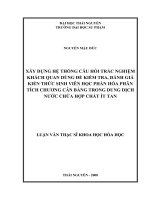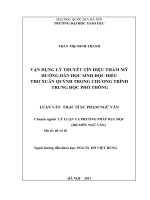ứng dụng địa thống kê trong tìm kiếm thăm dò dầu khí
Bạn đang xem bản rút gọn của tài liệu. Xem và tải ngay bản đầy đủ của tài liệu tại đây (7.1 MB, 22 trang )
Case Studies
Case Studies: Marathon Oil
Case Study: Statfjord Formation in the Statfjord Field
Case Study: Major Arabian Carbonate
Stochastic Modeling of Surfaces
Case Study:
3-D Reservoir Characterization for
Improved Reservoir Management
SPE 37699
M J. Uland, S. W. Tinker, D. H. Caldwell,
Marathon Oil
1
Permeability Cross-Section
North Brae Field
Permeability Cross-Section using the 2D maps from the original 13-layer Simulation
Model.
Net-to-Gross Maps
North Brae Field
Three of the original 13-layer model net-to-gross 2D maps used as
aerial templates for both the deterministic and stochastic 3D
models.
2
Permeability Cross-Section
North Brae Field
Permeability cross-section for the 140 layer deterministic 3D model.
Note the increased reservoir heterogeneity as compared to the
homogeneous 13 layer simulation model.
Permeability Cross-Section
North Brae Field
Permeability cross-section for the 120 layer stochastic 3D model.
Note the difference in the permeability distribution between this
model and the deterministic 140 layer model.
3
Permeability Cross-Section
North Brae Field
Permeability cross-section for the 27 layer simulation 3D model
that was upscaled from the 120 layer geostatistical model.
Net Pay Map and Model
Lawrence Field
Original 2D waterflood netpay map
showing one continuous grainstone
reservoir
Stratigraphic 3D model showing
individual grainstone bars that had
different waterflood responses
4
Connected Geobodies
Lawrence Field
Connected geobodies
from the 3D model. The
small red colored
geobodies represent
infill drilling targets
Production Results
Lawrence Field
The 20-acre infill drilling
results are shown in green.
In yellow is the base
production from the 40-acre
waterflood.
5
Simulation Models
Anonymous Field
The original 5-layer simulation
model using 2D maps
Upscaled porosity for the 21 flowunits used in the secondary recovery
3D model
Geobody Analysis
Anonymous Field
Geobody analysis from the 3D model indicates that a minimum of 20
flow-units would be needed to capture the higher permeability intervals
for use in a secondary recovery simulation model
6
Flow Unit Cross-Sections
Anonymous Field
Fine-layer porosity within the simulation
flow units
Upscaled flow-unit permeability using a porosityto-permeability transform. Superimposed on the
permeability flow-units are the vertical
transmissibility grids (shown in red) at the
interface of each flow unit
Cross-Sections
Yates Field
Cross sections showing stratigraphic
framework used to construct the 3D
geologic model (top) and the porosity
distribution within the 3D model.
Stratigraphic grids and lithofacies
regions are superimposed on bottom
right section
7
Fence Diagram of Permeability
Yates Field
Fence diagram of permeability. Permeability was calculated in every cell as a function
of porosity, lithology, pore type, texture and calcite cement. White boxes indicate
actual permeability from core analysis
Structural Cross-Section
Yates Field
Structural cross section showing porosity
distribution in upper figure with well control
(vertical white lines). Porosity from the
stratigraphic model was extracted and used to
populate a 3D elevation slice model composed of
140 five-foot thick layers. The figure on the right
is porosity from the elevations slice model. Note
how the porosity structure is preserved.
8
Turbidite Lobe GeoBodies
Ewing Bank 873 Field
Pre-development wells. Five turbidite
lobes based on seismic and well
control that were used to constrain
the reservoir porosity distribution in
the initial 3D model (left)
Post-development wells. Eight
turbidite lobes based on seismic and
well control that were used to
constrain the reservoir porosity
distribution in the current 3D model
(right)
Porosity Distribution
Ewing Bank 873 Field
Porosity distribution for the current 3D model using the 8 turbidite lobes as
constraints
9
Case Study:
Stochastic Modeling of Incised
Valley Geometries
Statfjord Field
AAPG Bulletin V 82
82. No 6 (June 1998)
A. C. MacDonald, L. M. Falt, A Hekton
Conceptual Framework for
Bounding Surfaces
Conceptual Framework for bounding surface development driven by cyclic base-level
fluctuations 1
fluctuations.
1, base-level
base level fall leads to the development of a regional erosion surface with incised
valleys, sequence boundary(SB1). 2, low rates of base-level rise/aggradation and confinement of
rivers within the valley produce a sand-rich valley fill that can be capped by a significant baselevel rise or flooding surface (FS1). 3, higher rates of base-level rise/aggradation and a wide,
nonconfined alluvial plain leads to the preservation of isolated channels within mudstone-rich
overbank deposits. 4, renewed base-level fall causes the development of the next regional
erosion surface (SB2)
10
Sequence Boundaries Composed
of Incised Valleys, Terraces and
Interfluve
Sequence boundaries are composed of incised regions (valleys) and flatter regions
(terraces and interfluves). Significant flooding surfaces can occur within the valley
(FS1), at the top of the valley (FS2), or within the nonconfined alluvial plain (FS3)
Stochastic realizations of
Sequence Boundaries
Realizations of 2D gaussian functions in map view and in cross section. The two surfaces
are simulated with identical parameters (and random seed numbers), except that
realization (1) uses and exponential variogram and realization (2) uses a gaussian
variogram. Note the anisotropy that is oriented 45 degrees with respect to the x-axis.
Scale is in meters
11
Parameterization of Valley Geometry
These figures illustrate the various steps involved in describing a single valley
associated with a single sequence boundary
Well Control and Sequence
Stratigraphic Correlations
12
Flooding Surface (FS4) Map View
and Cross Section Realizations
Sequence Boundary Realizations
Realizations of sequence boundary 5 in map and cross-section. The
average depth map (lower right) is based on 100 simulations.
13
Cross-Sections through two 3D
Realizations of Reservoir Stratigraphy
Gamma ray logs are at well locations. Sandstone-rich valley-fill units (VF1-5) are in reds,
yellows and greens; mudstone-rich units (HS0-4) are in blues and purples
Stochastic Realizations of 3D Model
3D reservoir architecture
of realizations 58 and 86.
The valley
y fills are
illustrated consecutively
from the base and
upward. The thickness of
each new valley fill is
illustrated with rainbow
colors where the reds and
yellow illustrate areas with
relatively thick valley fills,
and blues and illustrate
relatively
l ti l thi
thin valley
ll fil
file
and interfluve/terrace
areas. Well data:yellow
reservoir sandstone;
purple - mudstone rich
barriers
14
Statfjord Field Study Results
The simulated geometry's provided an improved description of reservoir distribution,
connectivity and barrier distribution
The improved reservoir description provided a better basis for predicting reservoir
performance and for designing well locations in complex fluvial reservoirs
Uncertainty in the reservoir architecture was accounted for by generating multiple
realizations
Statfjord Field Study
One Final Comment
“The main drawback to developing flexible, realistic models is that the number of
parameters that need to be estimated increases dramatically. The danger is that
overestimating these parameters will become overly tedious. Although there is clearly
a trade-off, this problem cannot be avoided totally, thus, geologists must equip
themselves with the analog data and develop appropriate procedures to simplify the
complex parameter estimation”
15
Integrated Reservoir Modelling of
a Major Arabian Carbonate
Reservoir
SPE 29869
J.P. Benkendorfer, C.V Deutsch, P.D
LaCroix, L.H. Landis, Y.A Al-Askar, A. A.
Al-AbdulKarim
Al
AbdulKarim, J.
J Cole
Major Arabian Carbonate Reservoir
Oil production from wells on a one
onekilometer spacing with flank water
injection. There has been significant
production and injection during the last
20 years
This has had rapid and erratic water
movement uncharacteristic of the rest
of the field and reason for building a
new geological and flow simulation
models
16
Modeling Process
Novel aspect was modeling
permeability as the sum of a
matrix permeability and a
large-scale permeability
fractures
vuggy and leached
zones
bias due to core
recovery
Typical modeling procedure
that could be applied to other
carbonates and to clastic
reservoirs
Indicator Simulation of Lithology
Presence / absence of limestone / dolomite was modeled with indicator simulation
on a by-layer basis
17
Gaussian Simulation of Porosity
Variogram model for porosity in limestone:
Variogram model for porosity in dolomite:
Gaussian Simulation of Porosity
Porosity models for limestone and dolomite were built on a by-layer basis then
put together according to the layer and lithology template
18
Indicator Simulation of Matrix
Permeability
Gaussian Simulation of LargeScale Permeability
Matrix permeability at each well location yields a K•hmatrix
Well test-derived permeability at each well location yields a K•total
Subtraction yields a K•hlarge
Vertical distribution of K•hlarge scale on a foot-by-foot basis is done by considering
multiple CFM data
19
Gaussian Simulation of LargeScale Permeability
Large-scale permeability models were built on a by-layer basis with SGSIM
Matrix permeability and large-scale permeability models were added together to yield
a geological model of permeability
A calibrated power average was considered to scale the geological model to the
resolution for flow simulation
Flow Simulation: First History
Match
20
Flow Simulation: Fourth History
Match
Stochastic Modeling of Surfaces
21
Stochastic Modeling of Surfaces
To assess uncertainty in pore volume or reservoir performance predictions requires
adding uncertainty to the gridded surface elevations.
Characteristics of the uncertainty
essentially zero at the well locations
varies smoothly away from the wells
variance depends on the quality of the seismic and the distance from the wells
Uncertainty at wells is 0
Uncertainty increases away from wells
22









